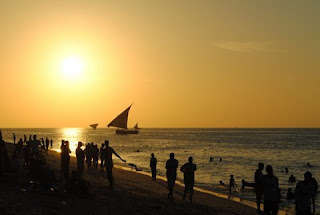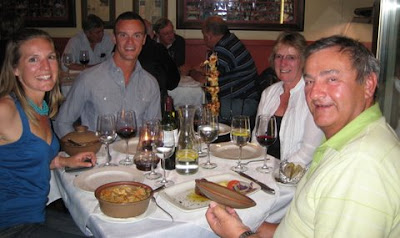Listen, my children, and you shall hear
Of the eight-day journey of eight mountaineers
Just everyday folks, not one a hero
But they all shared one dream – climb Kilimanjaro.
Now Garrett and Jess from Syracuse hail
Tried to train in the snow, sleet and hurricane’s gale
It’s a good thing there’s no power on Kili’s route
If there were, with these two, that pow’r soon would be out.
And Kylie’s adventure gene is off the charts
She comes from Down Under and has lived in most parts
She’s brilliant and caring and quite in the know
Except for that weird thing that others call snow.
Australians are known to drink ale, beer and lager
But whoever’d have thought they could hold so much water?
Larissa drank litres and litres each day
Then spent every night peeing it all away.
From West Africa’s desert Namibia
(A word that no poet would dare to rhym-i-bia)
Come our engaged sweethearts, Jules and Ant
Two volunteer workers who’ve never said “can’t”.
From Colorado in the U-S of A
John and I came for our winter get-away
Grandpa and grandma – “Babu” and “Bibi”
Is what Julius called us in his Swahili
Chiropractor, world traveler, endodontist, oh my!
Physiologists, grocery merchant, PhD candidate, and I
Unlikely companions, at least at first glance
But here’s how we formed such a strong alliance:
We bonded right off on that muddy first track
With bottles and backpacks flying off the truck’s rack
Proof once again - it’s never been wrong -
That which does not kill you will just make you strong.
A travelling pharmacy we soon discovered
With Diamox, Advil, and dozens of other
Prescription and over-the-counter drug aids
We cheerfully shared with each other each day
We did everything that the book from the store
Said would help us to acclimate: drink and drink more
Then we found a new way to force air in our lungs
Daily doses of laughter, dispensed by everyone
Still I haven’t a doubt there would be no success
Without our guide Joseph and without Julius
Through high lands and low, sure-footed and strong
We stepped in each footprint that they lead us on
Our meals were joyful and all of that laughter
Helped digest our food, then we lingered long after
To find we are owners of diabetic pets
Of dogs who have shingles and epileptic cats
“Habari!” “Nzuri!” mean, “What’s new?” “All is good!”
The answer to “Mambo” is “Poa” – it’s “cool”
“Acoonamatata”, “Karibu”, and “Ascente”
“All is well”, “welcome”, “thank you” – greeted us every day.
And now it’s day four, time to test our power
Up 600 meters to the Lava Tower
Worldwide the stock markets are all on the rise
Fueled by sudden unexpected ibuprofen highs
Day five no more tower, let’s take on the wall
And do not confuse short with easy, y’all
With Joseph and Julius showing us the ropes
We went up and over like eight mountain goats
The path sure was steep, the mud took its toll
We each gave new meaning to the words “rock ‘n roll”.
One ledge near the top was as thin as a wisp
To cross, it demanded a hug and a kiss
And the porters, oh my! Were our necks meant to hold
40 kilos of honey, coffee, milk and Milo?
Eggs and sausage, toast and porridge, it goes on and on
And that’s just one breakfast for my dear husband John.
All at once it is here, our big summit day
Are we ready, did we train right; is it too late to pray?
In the darkness we set off, with the moon bright and full
And the mountain awaiting aloof, quiet and cool
Finally, yes finally, we all reached the top
Inspired by each other not one of us stopped.
Take our photo, Dear Photo, proof that all of us stood
On the rooftop of Africa, still breathing! That’s good!
Acclimatization achieved! We brook no defeat
Except when we try to change meters to feet
So it’s back down the mountain, through rocks and through scree
Now we know why God gave everyone a spare knee!
On to Moise-town, gee the time sure went fast
Never thought I’d be saying I wish it could last
Just a day or two more, ‘cause we learned what few know
Time stands still when you’re climbing Mt. Kilimanjaro.
So what’s to become of this odd but brave troupe?
What’s the crystal ball say lies ahead for the group?
Well a magical man with a magical brew
Helped me take a look forward a decade or two.
Larissa finished med school at the top of her flight
Now she’s birthin’ those babies all day and all night
World renowned in her field, at the top of her trade
Thought she still can’t convert Fahrenheit to Centigrade.
Kylie’s adventure gene is still going strong
Making film documentaries, it’s where she belongs
With blue shirt and chinos as her attire
David Attenborough has finally given up and retired.
Ant and Jules have done a very great thing
They’ve returned to Namibia, Jules is queen, Ant is king.
Corruption’s been banished and Ant ruled, I have heard
That only the softest of butter may be served.
Garrett and Jess are fabulously rich
Their hiking pole access’ry line launched without a hitch
You could say that they’ve certainly come right along
Check it out for yourself at pole-pole dot com.
But what of their food distribution empire?
Well that was all solved with one brilliant hire
The new CEO, all agree is the best
The sign on the door says, “Just call me Jess”.
Babu and I? We’re successful, too
You see we’ve discovered the fountain of youth
More than diet and exercise, we must confess
With all due apologies to our dear Jess.
It’s taking the time to make friends young and dear
That sends the clock backwards, year minus year.
So let’s make a pact, in a decade or two
To all meet again, at the top of Meru!
(This poem was written over 6 days during our 8-day climb up Kilimanjaro, January 3-10, 2012. It is an effort to capture the memories of the wonderful people and place that is Mt. Kilimanjaro. It is dedicated to each member of our climbing team and our outstanding support team, headed by chief guide Joseph “Photo”)























































